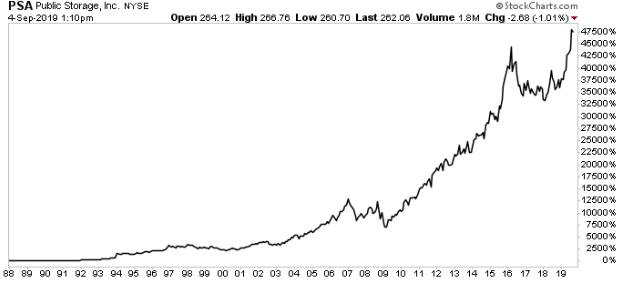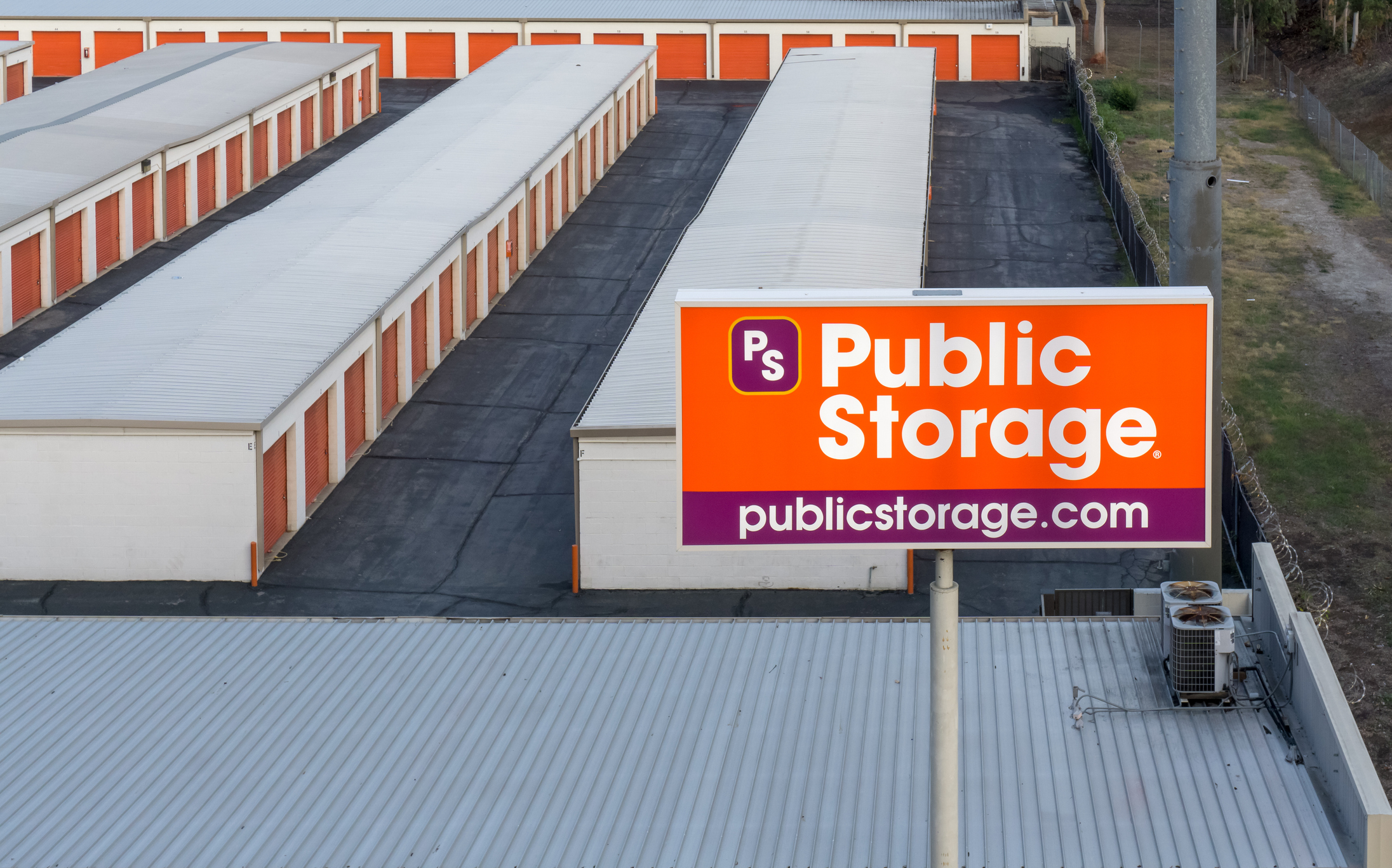Public Storage: For Income, There Might Not Be Any Better Stock Than This

Public Storage Has Delivered 32 Straight Years of Dividends
If you review past articles on Income Investors, you might spot a common theme: the best-performing stocks are often those of quiet, unassuming businesses that throw off steady income.
You can see this in names like Ecolab Inc. (NYSE:ECL) (cleaning supplies), Paychex, Inc. (NASDAQ:PAYX) (payroll processing), and Waste Management, Inc. (NYSE:WM) (trash collection).
None of these companies make for the best conversation around the office water cooler. But because they provide essential services and enjoy entrenched market positions, they throw off large, growing dividends to their investors.
Case in point today: Public Storage (NYSE:PSA). Over the past few decades, this partnership has quietly acquired thousands of self-storage warehouses. And while the firm hasn’t received much press coverage, there might be no better business in the world, especially if you like earning globs of dividend income.
Here’s why.
Quiet Business Throws Off Steady Dividends
Admittedly, self-storage has little sex appeal. In the world of real estate, people dream of striking it rich with gleaming office buildings or ritzy shopping malls. Who wants to invest in 10-by-15-foot lockers where Americans stash their extra stuff?
But while the business has all the excitement of filing your taxes, Public Storage has turned out to be a pretty solid investment—sometimes better than other commercial properties.
The partnership’s warehouses generate bond-like rental income, to begin with. In good times and bad, people still need repositories for their belongings that they can’t bear to toss out.
Moreover, low maintenance costs mean management can turn a profit with as little as 40% occupancy. And because moving is a big hassle, tenants won’t change locations just to save a few bucks at a different site. This allows Public Storage executives to raise rents year after year without the fear of losing business.
Of course, such attractive returns attract rivals. In 2018, developers spent more than $4.0 billion to add over 100 million square feet of storage facilities. That glut of new supply has swamped the market, pushing up vacancy rates and slowing the pace of rent hikes. (Source: “Where Does the Tidiness Craze Leave Self-Storage Stocks?” Bloomberg, March 9, 2019.)
By extension, this has reduced the attractiveness of new investment deals. The capitalization rate (a metric used by real estate analysts to provide a rough estimate of returns) on self-storage facilities has dropped from 7.5% in 2009 to six percent today. (Source: “Public Storage: A Recession-Proof SWAN You Can Trust,” Seeking Alpha, June 29, 2019.)
Piece by piece, competition chips away at profitability. Public Storage, however, has survived this onslaught better than most. Over the past few decades, management has focused most of the company’s investment dollars on California.
This market benefits from strict zoning laws and a scarcity of affordable land. Local residents also provide fierce resistance to new development. Those barriers to entry, to the benefit of shareholders, keep rivals out, rents high, and profits fat. In other words, a trifecta of great business characteristics.
For Public Storage stock investors, this has resulted in tidy returns. Management has paid a distribution to unitholders every year since 1987.
Even though the financial crisis, when many businesses slashed their payouts, Public Storage continued mailing out checks without so much as a hiccup. Over that period, PSA stock delivered a total return (capital gains plus dividends) of 13.5% annually. By comparison, the broader S&P 500 posted a yearly gain of only 10.5%.
And this could just be the beginning.

Chart courtesy of StockCharts.com
One Top Dividend Stock for the Next 10 Years
If you have spent any time in suburban America, then one fact becomes abundantly clear: we love our stuff. The median U.S. household size has almost doubled since the early 1970s. Yet despite adding basements, more rooms, and extra garages, people still can’t find enough space for their belongings. (Source: “New US homes today are 1,000 square feet larger than in 1973 and living space per person has nearly doubled,” AEI, June 5, 2016.)
That has created a boom for the self-storage industry. Today, about 50,000 self-storage facilities dot the country, twice the number that existed only 20 years ago. That means America now has more self-storage warehouses than McDonald’s and Starbucks locations combined.
That growth rate will likely accelerate in the years ahead. Each day, 10,000 baby boomers turn 65, enough to fill a city the size of St. Louis each month. And that demographic shift will continue until 2030. (Source: “Baby Boomers Retire,” Pew Research Center, December 29, 2010.)
As many in this generation downsize from “McMansions” to smaller living accommodations, many of their possessions will end up in self-storage.
And this trend isn’t the only one that benefits the self-storage industry. In reality, any big life event—from marriages and college graduations to career changes and natural disasters—can create new customers. Industry analysts call these drivers the “four Ds”: divorce, death, density, and dislocation.
Public Storage finds itself in the middle of this boom. Last quarter, the partnership’s occupancy rate stood at 94%, a near-record high. Annual rental income per square foot topped $17.55, up 1.7% from the same period last year. (Source: “Public Storage Reports Results for the Three and Six Months Ended June 30, 2019,” Public Storage, July 30, 2019.)
For the quarter, Public Storage’s core fund flows from operations, a common measure of profitability in the real estate business, were $ 2.64 per share. That’s a respectable 2.7% year-over-year jump.
Acquisitions have funded much of this growth. Since 2014, the partnership has spent $1.8 billion buying up small “mom and pop” operators with only a handful of locations. In a sense, the business resembles a hungry shark eating up the small fish in the pond. And these “meals” can be surprisingly profitable.
After these purchases, executives have two methods of squeezing more money out of these stores.
First is to slash overhead costs. By bringing small outlets into a bigger operation, individual stores can spend less on things like lawyers, accounting, business supplies, etc.
Second is to improve marketing efficiency. As the largest player in the business, Public Storage has access to the most customer data. Executives can also push media outlets for better advertising rates. This allows the company to generate more sales out of each marketing dollar spent.
In effect, this creates a virtuous cycle: Public Storage buys a business, which generates more rental income, which Public Storage uses to buy more businesses, which generates yet more income.
For Public Storage stockholders, this should translate into a respectable income stream. Right now, Public Storage pays a quarterly distribution of $2.00 per share, which comes out to an annual yield of about three percent.
Over the next five years, Wall Street is looking for Public Storage’s cash flows to grow at a high-single-digit clip. The partnership might be able to boost its growth rate further through larger acquisitions, assuming management doesn’t overpay. And given the firm’s conservative payout ratio (81% at the time of this writing), executives should have no problem boosting the distribution in line with profits.

(Source: “Public Storage (PSA),” “Yahoo! Finance, last accessed September 27, 2019.)
Bottom Line on This Growing Income Stream
In a nutshell, Public Storage is another unassuming business that has quietly posted blowout returns for investors. Even the partnership’s name can induce yawns!
But this trust continues to generate outsized cash flows. And with the demand for self-storage space poised to keep growing, you can expect the income stream from PSA stock to balloon in the years to come.











